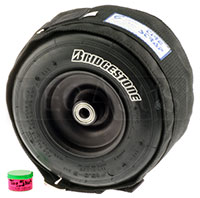SAFETY WARNING:
Serious injury or death may result from an explosion of the tire/wheel assembly due to the use of excessive pressure during mounting. Never exceed 35 psi (240 KPA / 2.4 Bar) to seat beads. During tire inflation always have assembly secured, stand clear and use a remote clip-on air hose. Only specially trained persons should mount tires.
- All Bridgestone and Firestone Race Kart tires are tubeless. Extra care must be taken to prevent leakage from both the tire and wheel. Always check for damage to the tire bead, O-ring (two-piece wheels), and wheel rim. Use special attention when mounting tires on cast one-piece wheels as any damage to the wheel may lead to a catastrophic failure when mounting.
- It is recommended that the tubeless valve "TR412" be used in all race kart applications.
- When mounting tires, always apply lubricant to the bead of the tire and the bead seat area of the wheel. Use extra care when mounting tire on one-piece wheels, as the tire bead is especially susceptible to damage.
- The maximum recommended tire seating pressure is 35 psi.
- After seating the tire, make sure that the bead of the tire is seated all the way around the circumference of the wheel on both sides.
- Once the tire is seated, reduce pressure to 6-21 psi.
- To ensure proper mounting, all Bridgestone and Firestone race kart tires display a directional sign on both sides of the tire.
- When mounted on the kart axle, both front and rear tires should rotate in the same direction as the arrows (>>) molded into the sidewall.


